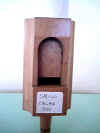
 SM240
Organ Pipe
circa 1960 Sound
SM240
Organ Pipe
circa 1960 Sound
In wind musical instruments, air in tubes is made to vibrate either by
means of a reed or of a fixed lip.
The latter is the principle of the organ pipe and the flageolet.
In the organ pipe, the air enters via a tube that is constricted to
produce a large velocity.
As the stream of air issues from the mouth of the pipe it meets
the lips, the upper one of which is beveled.
The mouthpiece is fixed at the end of a tube, which is open or
closed at the upper end to tune at the chosen pitch.
The rapid current of air entering the mouth strikes against the upper
lip and by virtue of the beveled edge will become turbulent or
pulsating.
The pulsations, transmitted to the air in the pipe make it
vibrate, producing a sound.
In order to produce a pure sound there must be certain empirically
determined relationships between the sizes and forms of the lips and the
size of the mouth to the frequency of the note to be produced.
The tube also must have a length that is large in relation to its
diameter.
The pitch depends mostly on the dimensions of the pipe and the
velocity of the current of air.

![]()
 Museum
Museum
![]()
 SM240
Organ Pipe
SM240
Organ Pipe![]()